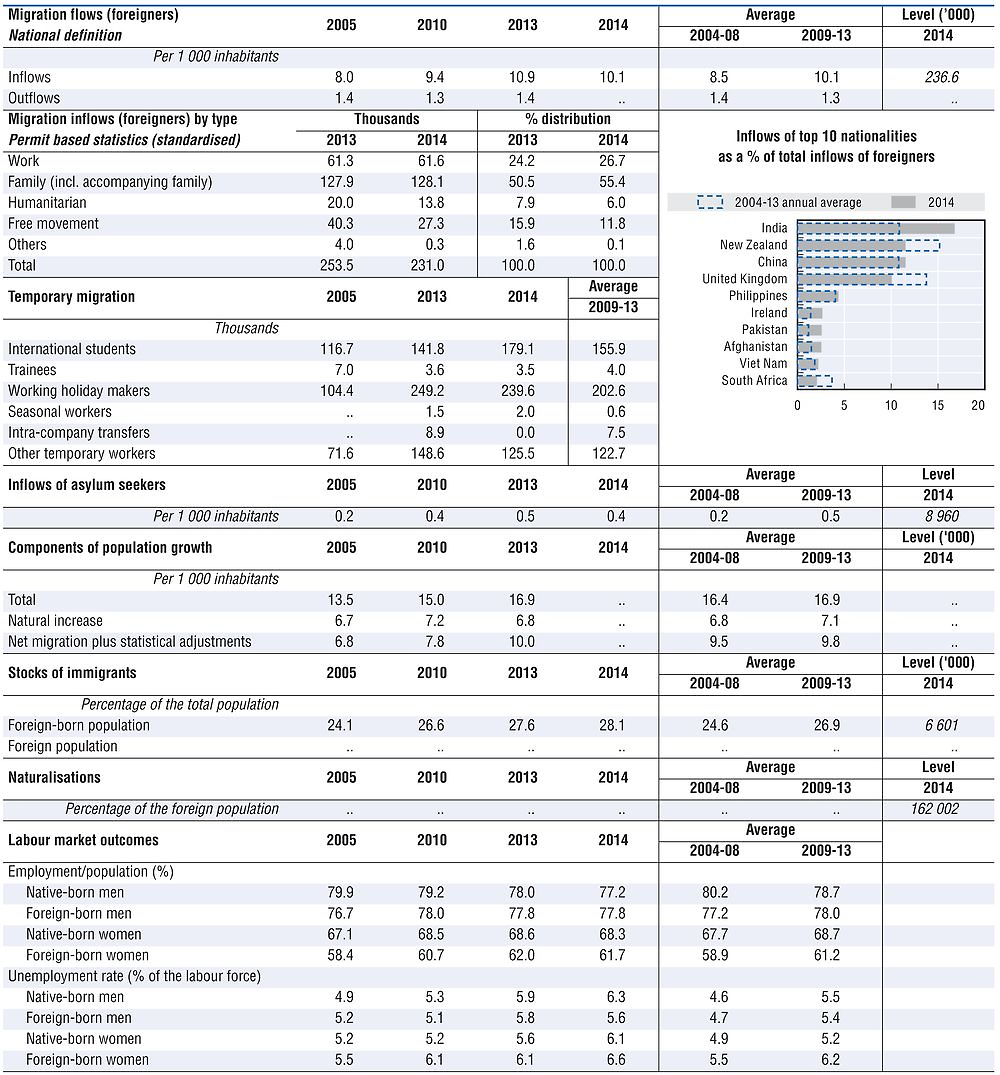Australia
Permanent migration fell by 1.2% in the 2014/15 programme year to 205 400. This comprised 189 100 places under Australia’s Migration Programme, 13 800 under the Humanitarian Programme, and an additional 2 500 places provided to New Zealand citizens. Two-thirds of the Migration Programme involved visas granted through the Skill stream (127 800 visas, 53.4% of which were granted to accompanying family migrants) and almost one-third through the Family stream (61 100). The remaining 240 visas (0.1 %) were delivered under the Special Eligibility visa category.
The Skill stream decreased slightly, by 0.6%. Overall, the sizeable decreases in regional sponsored categories were compensated by increases in other categories. Points-Tested Skilled Migration and permanent employer-sponsored visas accounted for 57.0% and 37.8% of the Skill stream, respectively. The remaining places (5.1%) were for Business, Innovation and Investment visas (three-quarters of them going to Chinese immigrants) and for the Distinguished Talent visa (0.2% or 200 places).
For the fourth year in a row, India was the top source country for the Migration Programme with 34 900 places (18.4%), down 10.6% from the previous year. China (27 900 places, up 4.1%) and the United Kingdom (21 100 places, down 9.2%) followed. In addition to this regulated migration, 23 400 New Zealand citizens entered Australia as permanent settlers under the Trans-Tasman Travel Arrangement.
In 2014/15, the Humanitarian Programme granted 13 800 visas – 11 000 under the offshore resettlement component and 2 700 under the onshore protection component. The leading countries of birth for people granted offshore visas were Iraq, Syria, Myanmar, Afghanistan and the Democratic Republic of the Congo. In response to the Syrian humanitarian crisis, the Australian Government announced that over the next 12 to 18 months, it would resettle a total of 12 000 refugees registered with UNHCR who have been displaced by conflicts in Syria and Iraq. This almost doubles the 2015/16 Humanitarian Programme to 25 750 places.
Demand for the Temporary Work (Skilled) visa (Subclass 457) decreased slightly in 2014/15, with grants falling 2.5% over the year to 96 100. India (25 200) was the top nationality for the third year in a row, followed by the United Kingdom (14 700) and China (6 700).
The number of Student visa grants in 2014/15 rose by 2.6% to reach 299 540, their second highest level on record. Chinese students were the number one source with 65 700 visas granted, an increase of 9% over the previous year, followed by India (29 600, down 13.4%) and Korea (13 200, up 2.7%).
In 2014/15, 214 800 Work and Holiday visas were granted – a decrease of 6.3% from the visas granted the previous year. Grants of renewed Work and Holiday visas fell for the first time since their inception in 2005/06, from 45 600 in 2013/14 to 41 300 in 2014/15.
A record 4.3 million Visitor visas were granted in 2014/15 to applicants from outside Australia – an increase of 7.9% over 2013/14. China was the top nationality (658 400 visas granted), followed by the United Kingdom (556 100) and the United States (425 900).
Acting on recommendations of the Independent Review into the Subclass 457 Visa Programme, in 2015 the government implemented a number of changes. These included amendments to English language requirements; sponsorship approval periods; information-sharing provisions; and provision of more evidence-based policy. The government effected these changes by reinstating the Ministerial Advisory Council on Skilled Migration, and establishing a dedicated labour market resource that will provide technical advice on the current state of that market. The Migration Amendment (Charging for a Migration Outcome) Act was introduced in response to the Review’s recommendation to establish that it is an offence for sponsors to be paid for a migration outcome.
Further recommendations set for implementation include introduction of a new training scheme to improve opportunities for Australians and to streamline processing for low-risk sponsors in the Subclass 457 Visa Programme, as well as a review of the Temporary Skilled Migration Income Threshold.
In June 2015, the government announced the introduction of a simplified international student visa framework. The changes will mean a reduction in the number of student visa subclasses from eight to two, and introduction of a simplified single immigration risk framework for all international students.
In view of the tremendous increase in the number of visitors from China, the Department of Immigration and Border Protection is implementing new Visitor visa initiatives. In a trial run due to be implemented by the end of 2016, Chinese nationals will be eligible for a Visitor visa with a ten year validity. Applicants choosing this option will be entitled to visit Australia for up to three months on each entry. Other initiatives include a fast-track processing service and the expanded availability of online visa applications.

